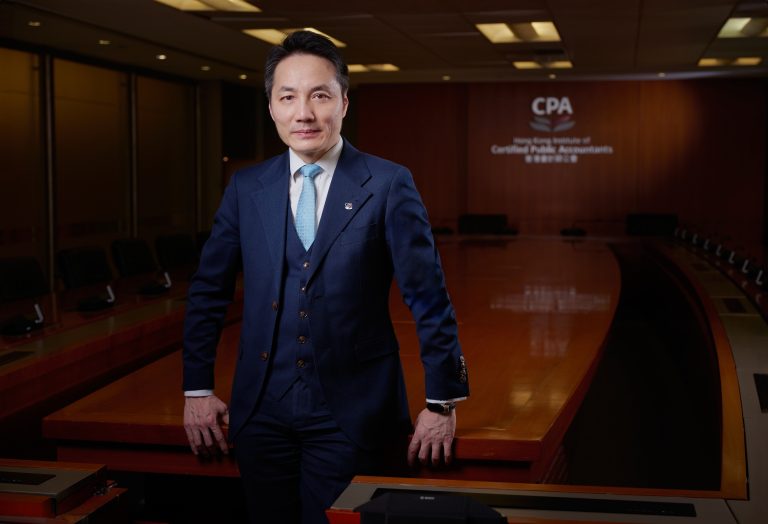Being chased by the press is not a situation most accountants experience. But for Terry Kan, Partner at ShineWing and Chairman of the Institute’s Restructuring and Insolvency Faculty (RIF) Executive Committee, it was a regular occurrence in 2016 when he was appointed provisional liquidator of gym chain California Fitness. “The case was in the newspaper almost every day. Every time we went to court, lots of reporters would follow us, trying to get first-hand information,” he remembers.
Kan was on holiday with his family when he received the call about becoming provisional liquidator of the chain. “I said, ‘You guys enjoy the holiday, I will be in Hong Kong and I’ll see you on the mobile phone.’” But he has no regrets about cutting his trip short. “[In restructuring] you have a certain period of time, and if you miss it, the clock cannot be turned back and you cannot do things differently,” he says.
California Fitness, which had 700 employees and 12 fitness centres in Hong Kong, as well as connections in Mainland China and Singapore, had debts of more than HK$300 million when Kan was appointed, much of which was owed to landlords. The restructuring was further complicated by the fact that thousands of its customers had left personal belongings in the group’s fitness centres.
Kan’s team eventually managed to reunite customers with their belongings and sell the business. “An investor in Hong Kong took over the business and dealt with liabilities on the commercial leases, and re-hired 200 of the former employees. It was a better outcome than having the company liquidated in a piece-meal manner,” he says.
Preserving jobs
It was the ability to save companies and jobs that attracted Kan to insolvency. He first came across liquidation and restructuring when he was studying accounting in Australia, and it struck him as being an interesting and challenging aspect of the commercial world. “I thought if you were good enough to save a company from going into liquidation, you could preserve a lot of jobs, contracts and assets,” he says.
After graduating, he joined Kwan Wong Tan & Fong in Hong Kong, which later merged with Deloitte, as a junior auditor, but when an opening came up at the Official Receiver’s Office in Hong Kong, he jumped at it. “I was an insolvency officer, responsible for case management and daily administration of court compulsory liquidations and personal bankruptcy cases. I learned from scratch and picked up technical knowledge, and combined it with actual real-life issues that came through my desk,” he says.
In 1997, during the Asian Financial Crisis, he decided to move back into the practising sector. He joined KPMG, spending 10 years with the firm, including an 18-month secondment in London, before moving to Grant Thornton and now ShineWing.
“At the end of the day, I am the one who is responsible to the stakeholders and the court.”
Kan has now been working in insolvency, restructuring and investigation for more than two decades. “I still enjoy it, and I am still learning. The economic environment is quite challenging these days and business transactions are more complex than they were in the past. It is a very fulfilling career.”
He adds that a big part of what he does involves building relationships and reputation so that creditors and other stakeholders will see him as being a suitable person to handle the cases in which they are involved. He explains: “Insolvency appointments are all personal engagements. Although I have the strong backing of the firm, at the end of the day, I am the one who is responsible to the stakeholders and the court.”
While Kan concedes that insolvency practitioners often have a negative image, as people may see them as trying to wind up companies that are failing, he points out that they are actually working to find solutions that will resolve disputes, safeguard the interests of creditors, preserve jobs and save companies. He adds that in their role as officer of the court, insolvency practitioners are also often the first people to carry out a statutory investigation and help to bring any wrongdoers to justice. “When everything falls apart, people count on an insolvency practitioner to pick up the pieces.”
In 2016, Terry Kan was appointed provisional liquidator of gym chain California Fitness, which had debts of more than HK$300 million.
Growing complexity
Working as an insolvency practitioner is not without its challenges. Kan says insolvency cases are significantly more complex now than they were 20 years ago, due in part to an increase in companies with only intangible assets, as well as a rise in companies with cross-border assets. “You have to find out where these assets are, what the likely chance is of recovering them and what costs are involved.”
He explains that, commonly, insolvency practitioners cannot act outside of their own jurisdiction, so they need to obtain assistance from other practitioners usually overseas, making it important to maintain good relationships with firms across the world. Even so, he stresses there is no easy way to complete the task of asset tracing.
Kan says some companies appear not to have any assets or money, either because these have been hidden or because key players have disposed of them in a bid to try to save the company, without necessarily realizing they may be acting unlawfully. “We always need to remind ourselves to think outside of the box, otherwise it can seem like a hopeless situation. We need to look for anything that could lead to the subsequent realization of assets, so we try to gather as much information as possible, then we use our professional experience and judgement to prioritize certain areas that we think will generate some cash and try to formulate a plan.”
He remembers two years ago when he was trying to trace assets that were in the Bahamas. “I didn’t even know exactly where the Bahamas was. I had to Google it! It took me two days to get there. I then worked for two days and it took me another two days to fly back to Hong Kong. But it opened my eyes and I was able to meet new people and understand more about how things worked,” he says.
A lack of immediate financial resources to enable insolvency practitioners to carry out their work can also be a struggle. “The best way forward is for creditors to provide additional financial support so that insolvency practitioners can get on and try to recover larger pools of money and assets for them, but they are not always willing to do this.” In some cases, a market solution has been developed by global investment and legal professionals which provides litigation funding, giving insolvency practitioners sufficient resources to start a recovery action, in exchange for a return on the money out of the eventual realizations.
No formal regime
A particular challenge for insolvency practitioners in Hong Kong is the jurisdiction’s lack of a formal corporate rescue or restructuring framework. Instead, a typical way to start a restructuring process is to appoint a provisional liquidator, which leads to legal actions against a company being put on hold, providing breathing space to start negotiating with creditors. However, such a statutory arrangement requires court approval on a case-by-case basis.
The Hong Kong government has been looking to introduce a formal regime for the restructuring process, such as the United Kingdom’s administration arrangement or the United States’ Chapter 11 bankruptcy, for more than 20 years and it has previously prepared two draft bills, but these have never been passed by the legislature due to issues around how to balance the competing interests of different stakeholders. A third version of the corporate rescue procedure bill is now planned to go before the Legislative Council.
Kan says the current lack of a formal restructuring regime is an issue for Hong Kong and has contributed to its having a lower ranking in the World Bank Group’s annual Doing Business study.
He explains that having a good and extensive insolvency regime is an important factor in attracting investors, as they want to have predictable and efficient mechanism to exit their investment if things go bad.
He adds that while the insolvency regime in the U.S. is debtor-friendly, the proposed Hong Kong regime, originally put forward by the Law Reform Commission in 1996, follows the U.K.’s approach and is more creditor-friendly. “Ideally, we should strike a balance between these two approaches. They are both good systems for different situations.” He stresses that the new restructuring legislation must be workable from the point of view of lenders and corporates, as well as insolvency practitioners, otherwise they are unlikely to use it.
The new legislation comes as insolvencies in Hong Kong are already increasing as a result of the economic downturn. Kan says more than 20 listed companies are currently being sued by creditors, with a backlog of cases waiting to be heard after court hearings were suspended due to COVID-19. Going forward, he expects the total number of business failures to be more than double the level seen in the past two years.
Kan is Chairman of the Institute’s Restructuring and Insolvency Faculty Executive Committee as well as a board member of INSOL International.
Giving back
Kan is highly involved in the professional bodies associated with the insolvency sector. As well as the Chairman of the Institute’s RIF Executive Committee, he is also a board member of INSOL International, the world’s largest insolvency organization, which promotes best practice globally and fosters international collaboration.
His work with the RIF keeps him busy, with the faculty not only running monthly seminars and events, but also responding to government and industry consultations on behalf of the insolvency profession in Hong Kong. As well as contributing to the development of the corporate rescue procedure bill, it also commented on proposed rules under the Financial Institutions (Resolution) Ordinance, which provides mechanisms to rescue distressed financial institutions, and provisions on how long listed companies with shares suspended from trading should be given to resume trading under new delisting regime introduced by the Hong Kong Stock Exchange. “On top of this, we have been working on our own advice and guidance materials, including publishing a quick guide for businesses and individuals facing financial distress and updates on the Liquidation and Insolvency Guidance Notes, the Institute’s best practice guidance for insolvency practitioners.”
Kan also spends a lot of time giving presentations and training sessions to different professional bodies, and helping the Institute run the Professional Diploma in Insolvency, which he has been involved in for over 10 years. “I still enjoy doing it because it makes me pick up textbooks and read about new developments. It is an opportunity to help, but I always think anyone who is a trainer gains the most.”
On top of all of these commitments, he also co-authored the fourth edition of the Hong Kong Corporate Insolvency Manual, which included a new chapter on ethical issues. This inclusion was driven by an amendment to the Companies (Winding Up and Miscellaneous Provisions) Ordinance in 2014, which introduced new conflict and disclosure requirements, as well as a desire to promote Section 500 Professional Ethics in Liquidation and Insolvency of the Institute’s Code of Ethics for Professional Accountants. “As an officer of the court, we are expected to demonstrate the highest professional and moral standards. We exercise professional judgement on commercial issues on a daily basis, so we need to have a good ethical backing behind what we do,” Kan says.
An inquisitive nature
Kan thinks having an inquisitive mind and an interest in the commercial world are important qualities for anyone who wants to work in insolvency. “You must be curious to know what happened to a company, why did it run into problems, what caused the issues?”
They should also have the ability to come up with creative solutions to help save companies. “We need people who can think outside of the box. Because of their training, accountants are used to following a set of procedures, but when it comes to restructuring and insolvency matters, you need to find a solution for a company that is workable.”
He adds that people should be able to work in chaotic situations and have good people skills to help mediate disputes and win the trust and confidence of those involved in a restructuring.
“You must be curious to know what happened to a company, why did it run into problems, what caused the issues?”
Kan says anyone who is interested in finding out more about becoming an insolvency practitioner is welcome to join the faculty’s activities, even if they are not a member. He notes that the Institute’s Insolvency Preparatory I, which is due to start in September, offers a good foundation in the discipline, while, for those who want to study the area in more depth, the Institute also offers Insolvency Preparatory II and the Professional Diploma in Insolvency to take the studies further.
Kan’s own inquisitive nature is reflected in his varied hobbies. “I like taking photographs and hiking with my family and dog. I have started riding a bike from Shatin to Tai Po. It is a really lovely area to exercise in. I also love reading all kinds of different books.” He adds that he has recently begun watching videos on YouTube. “There are lots of things to watch. I try to keep myself young so that I have something to talk about with my two teenage boys.”
The Restructuring and Insolvency Faculty (RIF), launched in 2008, was the first specialist faculty established by the Institute. The RIF holds regular lunchtime seminars and other networking events, among other activities. It is open to both Institute members and non-Institute members.

















